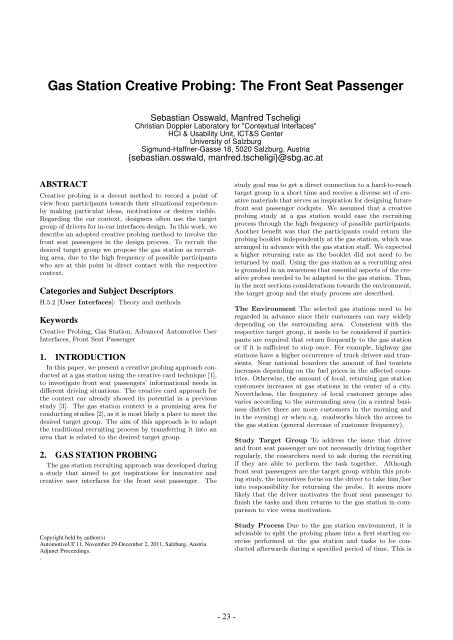Automotive User Interfaces and Interactive Vehicular Applications
Automotive User Interfaces and Interactive Vehicular Applications
Automotive User Interfaces and Interactive Vehicular Applications
You also want an ePaper? Increase the reach of your titles
YUMPU automatically turns print PDFs into web optimized ePapers that Google loves.
Gas Station Creative Probing: The Front Seat Passenger<br />
ABSTRACT<br />
Sebastian Osswald, Manfred Tscheligi<br />
Christian Doppler Laboratory for "Contextual <strong>Interfaces</strong>"<br />
HCI & Usability Unit, ICT&S Center<br />
University of Salzburg<br />
Sigmund-Haffner-Gasse 18, 5020 Salzburg, Austria<br />
{sebastian.osswald, manfred.tscheligi}@sbg.ac.at<br />
Creative probing is a decent method to record a point of<br />
view from participants towards their situational experience<br />
by making particular ideas, motivations or desires visible.<br />
Regarding the car context, designers often use the target<br />
group of drivers for in-car interfaces design. In this work, we<br />
describe an adopted creative probing method to involve the<br />
front seat passengers in the design process. To recruit the<br />
desired target group we propose the gas station as recruiting<br />
area, due to the high frequency of possible participants<br />
who are at this point in direct contact with the respective<br />
context.<br />
Categories <strong>and</strong> Subject Descriptors<br />
H.5.2 [<strong>User</strong> <strong>Interfaces</strong>]: Theory <strong>and</strong> methods<br />
Keywords<br />
Creative Probing, Gas Station, Advanced <strong>Automotive</strong> <strong>User</strong><br />
<strong>Interfaces</strong>, Front Seat Passenger<br />
1. INTRODUCTION<br />
In this paper, we present a creative probing approach conducted<br />
at a gas station using the creative card technique [1],<br />
to investigate front seat passengers’ informational needs in<br />
different driving situations. The creative card approach for<br />
the context car already showed its potential in a previous<br />
study [3]. The gas station context is a promising area for<br />
conducting studies [2], as it is most likely a place to meet the<br />
desired target group. The aim of this approach is to adapt<br />
the traditional recruiting process by transferring it into an<br />
area that is related to the desired target group.<br />
2. GAS STATION PROBING<br />
The gas station recruiting approach was developed during<br />
a study that aimed to get inspirations for innovative <strong>and</strong><br />
creative user interfaces for the front seat passenger. The<br />
Copyright held by author(s)<br />
<strong>Automotive</strong>UI’11, November 29-December 2, 2011, Salzburg, Austria<br />
Adjunct Proceedings.<br />
.<br />
- 23 -<br />
study goal was to get a direct connection to a hard-to-reach<br />
target group in a short time <strong>and</strong> receive a diverse set of creative<br />
materials that serves as inspiration for designing future<br />
front seat passenger cockpits. We assumed that a creative<br />
probing study at a gas station would ease the recruiting<br />
process through the high frequency of possible participants.<br />
Another benefit was that the participants could return the<br />
probing booklet independently at the gas station, which was<br />
arranged in advance with the gas station staff. We expected<br />
a higher returning rate as the booklet did not need to be<br />
returned by mail. Using the gas station as a recruiting area<br />
is grounded in an awareness that essential aspects of the creative<br />
probes needed to be adapted to the gas station. Thus,<br />
in the next sections considerations towards the environment,<br />
the target group <strong>and</strong> the study process are described.<br />
The Environment The selected gas stations need to be<br />
regarded in advance since their customers can vary widely<br />
depending on the surrounding area. Consistent with the<br />
respective target group, it needs to be considered if participants<br />
are required that return frequently to the gas station<br />
or if it is sufficient to stop once. For example, highway gas<br />
stations have a higher occurrence of truck drivers <strong>and</strong> transients.<br />
Near national boarders the amount of fuel tourists<br />
increases depending on the fuel prices in the affected countries.<br />
Otherwise, the amount of local, returning gas station<br />
customers increases at gas stations in the center of a city.<br />
Nevertheless, the frequency of local customer groups also<br />
varies according to the surrounding area (in a central business<br />
district there are more customers in the morning <strong>and</strong><br />
in the evening) or when e.g. roadworks block the access to<br />
the gas station (general decrease of customer frequency).<br />
Study Target Group To address the issue that driver<br />
<strong>and</strong> front seat passenger are not necessarily driving together<br />
regularly, the researchers need to ask during the recruiting<br />
if they are able to perform the task together. Although<br />
front seat passengers are the target group within this probing<br />
study, the incentives focus on the driver to take him/her<br />
into responsibility for returning the probe. It seems more<br />
likely that the driver motivates the front seat passenger to<br />
finish the tasks <strong>and</strong> then returns to the gas station in comparison<br />
to vice versa motivation.<br />
Study Process Due to the gas station environment, it is<br />
advisable to split the probing phase into a first starting exercise<br />
performed at the gas station <strong>and</strong> tasks to be conducted<br />
afterwards during a specified period of time. This is





